#post tom
With the release of AKIBA’S BEAT for PS4 and Vita alike less than a week away (or just over a week away, if you’re in Europe), we thought it might be nice to take a closer look at the game’s “Delusionscapes” – the dungeons created within the Tokyo district of Akihabara that make up roughly one half of the game’s playtime. Some fans have been unclear as to what these are and how they work, so we figured we’d show you some of the original concept art from several choice Delusionscapes, along with providing thorough descriptions of how each one – and the delusion that spawned it – fit into the game’s setting and overall story.
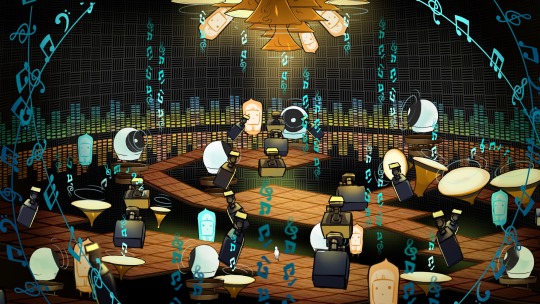
Audio Delusionscape
For a brief moment in time, Akihabara was an audiophile’s dream, with stereo equipment plentiful and knowledgeable staffers on every corner. But when’s the last time you saw someone excitedly buying a several thousand-dollar boffo stereo setup with amp, subwoofer, big honking speakers, etc.? I’m willing to bet it wasn’t anytime since the turn of the millennium, and Akihabara – its finger ever on the pulse of current technological trends – reflects that, with the audio niche being all but gone from the Akiba streets of today.
One of the central themes of AKIBA’S BEAT, however, is that sometimes, people simply cannot accept change… and in the Akiba depicted here, those who have a strong affinity for the way things used to be can actually change reality to make it that way again.
One music hipster dude, who runs one of the few surviving audio specialty stores in Akihabara, did exactly that, and created this Delusionscape full of the most amazing audio equipment you’ve ever seen (with perfect acoustics, no doubt!). And where did he create it? Why, at the heart of Akiba, of course: Akihabara Station, where all those heading to or from the district inevitably must go. From the outside, it just looks like the station’s got a larger-than-life sound system attached to it, but on the inside, it’s a maze of graphic equalizers and top-of-the-line gear.
The key part of this delusion, however, is the effect it has on the people of Akihabara, unconsciously causing Akiba residents and tourists alike to have a strange desire to go out and buy new audio equipment…

Idol Delusionscape
Cuteness, pinkness, and bunnies rule the day here, as the site of a simple concert fronted by up-and-coming idol singer Riyu Momose turns into an absolute idol paradise. Throngs of adoring (and rather creepy) fans flock to the site, guided to it like a beacon in the night, leaving our heroes with a bit of a conundrum: who among this crowd of hundreds – nay, thousands – could be the “deluser” responsible for dreaming up such a venue?
On the inside, the Idol Delusionscape shares its outer appearance, but dials it all up to eleven with neon color-changing lights and whimsical designs around every corner. One can only imagine the Grand Phantasm (read: boss) that awaits at the end of such a high-energy labyrinth!
The Idol Delusionscape is when the story of AKIBA’S BEAT really starts to kick into gear, presenting players with a large list of suspects as to who might be responsible for its creation, and forcing them to do some true sleuthing in order to find the answer. Is it the jovial yet overbearing Chunk Widebody? The scrawny, sweaty, and devious Twiggy Slims? Or perhaps it’s the shy, awkward Megane Taro, who seems – by all accounts – to recognize that something isn’t quite right about all of this…
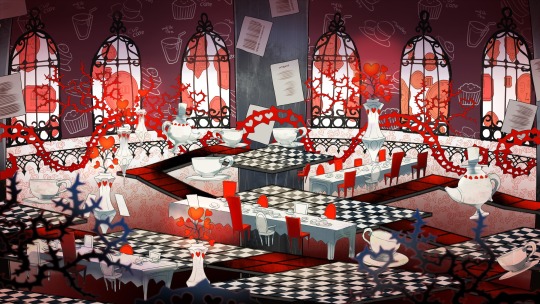
Maid Delusionscape
As with the Audio Delusionscape, this one represents a period in Akiba’s history that’s only just now starting to come to a close: the maid boom. Maid cafes are a staple of Akiba culture, allowing reclusive “otaku” (read: nerds) not only to eat lovingly prepared food full of hearts and flowers and frills, but to have cute girls in maid outfits waiting on them hand and foot the whole time, calling them “master” and doing everything in their power to cheer them up with song and dance routines, magic shows, games… whatever it takes!
Maid cafes are still abundant in Akihabara today, with locations like Maidreamin and Granvania serving as landmarks to travelers in the district, and girls in full maid outfits still handing out sale flyers to passers-by on a daily basis. However, if you went back in time only a few years – roughly to the period when AKIBA’S TRIP: Undead & Undressed was released – you’d find maid culture to be more of a dominant force than it is today. In other words, it’s still going strong… but it’s noticeably waning, losing ground to idol culture and other otaku whims.
This is where the Maid Delusionscape comes in. From the outside, it appears as a beacon of maid symbology (frilly lace, rice omelettes with ketchup hearts drawn on them, etc.) at the site of an in-universe branch of the “Maidiators” cafe – and this carries through to the inside as well (albeit with more imagery of bars and chains, suggesting the “deluser” responsible for this delusion might feel a bit trapped). But it’s the effect the maid delusion has on Akiba that’s most noticeable, essentially restoring the maid boom in full… and then some. As long as the Maid Delusionscape exists, maids will be more popular in Akihabara than ever, surpassing their peak numbers from the early-to-mid 2010s. And if that happens… well, it doesn’t sound all that bad, does it? But one could argue that it’ll cause the district to be thrown out of balance, losing its propensity for change. And without that, Akiba just isn’t Akiba anymore!
As such, the Maid Delusionscape chapter is the first time the game’s characters really start to ask: is it right to destroy someone’s delusion, even when it doesn’t seem to be doing any harm? Should delusions be condemned simply for “defacing reality”? Or should they, under certain circumstances, perhaps be embraced?
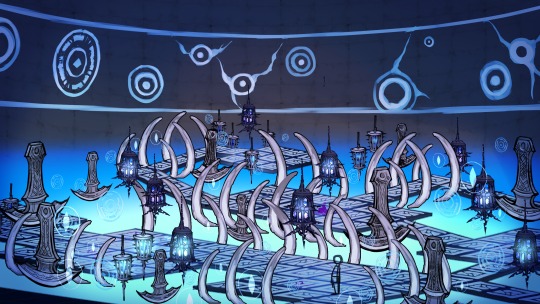
“Chuuni” Delusionscape
There are numerous Japanese terms that come up so regularly in the anime fandom, they’ve basically become adopted into the worldwide “anime lexicon” at this point. “Baka,” for example, is a word most anime fans know means “idiot,” and “tsundere” is a word most anime fans know refers to someone who’s mean and abrasive on the outside to cover up her (usually her) inner emotionality.
One that doesn’t come up as often, however, but is absolutely key to understanding the story of AKIBA’S BEAT (and is thus left untranslated, but clearly outlined to players during the course of the game, even in the original Japanese), is “chuuni.” Literally “junior high sophomore,” it’s an abbreviated version of the larger slang term “chuunibyou,” or roughly “eighth-grade sickness.” This somewhat derogatory term refers to people who are obsessed with the types of “edgy” things typically associated with fiction targeted toward eighth-graders: large unwieldy swords, characters with mysterious pasts, pretentiously poetic dialogue that obscures the meaning of crucial passages, heroic acts of self-sacrifice, focusing one’s power “over 9000,” etc.
This Delusionscape, then, is fairly low-key and personal compared to a lot of the others in the game. Its effects on the district are minimal, but those who dare to enter it are met with a unique brand of opposition in the form of a dark-cloaked man with a large axe who speaks in riddles. The key to passing by him is solving his riddles, and the key to that is finding the source of the delusion – the person who dreamed up this den of tired anime stereotypes in the first place. But can that be done before the power of the Chuuni Delusionscape collapses in on itself like a neutron star?! Find out next time… on AKIBA’S BEAT!

Electronics Delusionscape
This is one of the more surprising Delusionscapes in the game, I think. When you hear “electronics,” you probably aren’t picturing quite what you get here – verdant green grass and moss, with a general feeling of nature encroaching upon everything around you. How does this relate to electronics? Well, if you look a bit closer, you’ll see: mixed in with all the foliage (indeed, almost camouflaged by it) are air-conditioning units, fans, microwaves, washing machines, refrigerators, and all manner of other home appliances (you don’t actually have to look THAT close in the concept art image, but in-game, these appliances are a bit fewer in number and more well-hidden). These aren’t the electronics that first spring to mind when most of us hear the word, but make no mistake: these are the electronics that made Akihabara what it is today. And here, they’re shown as being forgotten… abandoned… left out for so long that they’re overgrown with moss and vines, likely never to function again.
This is the delusion of someone who controls a vast empire of home appliances, but either regrets that he’s still living in Akihabara’s past, or is afraid his goods will be rendered obsolete by newer, more advanced inventions. It’s the delusion of an insecure store owner – the hidden underbelly of a “home appliance boom” that’s happening on the outside, with people suddenly snatching up home appliances in droves like never before… when in reality, one rarely goes to Akihabara for home appliances these days. The meaning of “electronics” – indeed, of “Electric Town” in general – has changed into a completely different beast over the last few decades. And there are clearly some who would prefer not to change with it, and will fight tooth and nail to keep things the way they once were.
Represented in one of the more emotional chapters of AKIBA’S BEAT, the events surrounding the Electronics Delusionscape hit pretty hard, and may be some of the more memorable and intense moments found in the entire game.
They are also, sadly, very easy to spoil, so I shall speak no more on the subject!
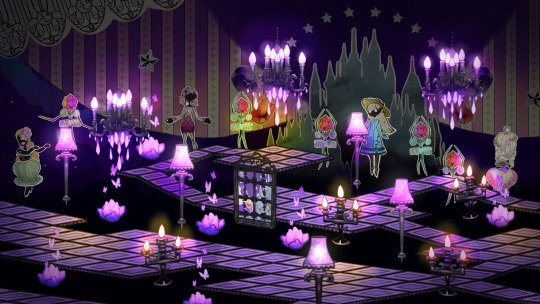
In fact, to talk about any of the other Delusionscapes at this point would be virtually impossible without spoiling crucial story scenes, so suffice it to say we’ve only just scratched the surface here – there are many, many more in this game, each with their own story to tell!
If you could make any delusion into reality, what would your delusion be? Where would it be located, and what effect would it have on your town/city/village/trailer park/biodome? What would the inside of its Delusionscape look like, and what “Grand Phantasm” – representative of the core concept from deep within your soul that spawned this delusion in the first place – would await at the end of it?
We’ve been asking ourselves that very same question here at the XSEED offices, and if you’re lucky, maybe we’ll share a few of our answers with you in a future blog. Because let me tell you, we’re all delusers, baby (though please don’t kill us!).
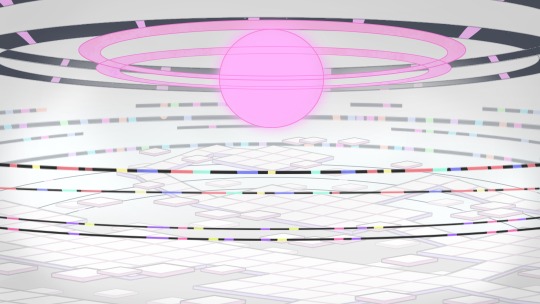
In the meantime, you can join Asahi & co. on their delusion-filled journey May 16th in North America or May 19th in PAL regions, on PS4 or Vita, both versions containing dual voice and dual text (so you can play with any combination you’d like of Japanese or English voice-acting or text). And in fact, although we previously stated that players would have to download the Japanese voices as free DLC for the Vita version, it turns out we were able to include them as part of the base game after all, so all users on both PS4 and Vita will have all voice and text options in all English-speaking regions, right from the start.
Are you ready to be deluded?
Greetings, future Zweiholics! Are you ready to learn a bit more about Zwei: The Arges Adventure, our upcoming action RPG slated for release on Steam, GOG, and The Humble Store by Humble Bundle on Wednesday, January 24th? Well… you’re in luck, because I’m ready to knowledge-bomb you like nobody’s business!
Last time, we talked about some of the more fascinating elements that were encountered during localization which are no longer present in the game, so this time, what say we talk about some of the more interesting elements that are totally still there (in one form or another, anyway), just waiting to be discovered?
For starters, let’s discuss the masked “master” character, who serves the same function in Zwei: The Arges Adventure that Gallandeau served in Zwei: The Ilvard Insurrection: he teaches you new “arcana” (read: combo moves) at the end of very specific dungeon paths. Except… all of those dungeon paths are 100% optional, so you could theoretically go through the entire game without ever even meeting him. Until the point in the plot when you’re forced to meet him, anyway! And once you reach that point, he reveals his true identity, meaning he’s no longer a mysterious masked master.
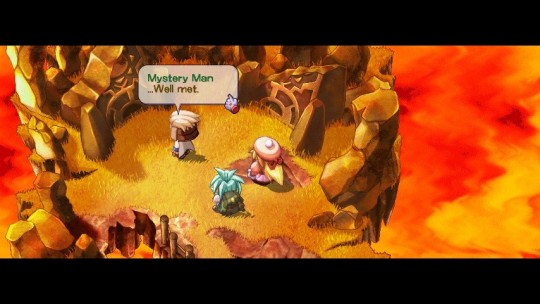
So what happens if you wait until after he’s unmasked himself, THEN hit up all the arcana paths in the dungeons?
Well, for one thing, his unmasking scene plays out quite a bit differently, since Pokkle and Pipiro will be meeting him for the very first time (a scene I had a lot of fun writing, particularly when Pipiro calls him “the living embodiment of stranger danger”). But then after that, when you proceed down the arcana paths, you’ll find no master awaiting you at all. Instead, you’ll simply find books! Books that give you electric shocks when you read them, teaching you the missing new arcana in the process (and leading to some pretty funny conversations between the two protagonists as they hold off touching the tingly tomes as long as possible, since they know just what’s coming when they finally give in – or rather, when Pokkle finally gives in, since Pipiro sure ain’t touchin’ that crap!).
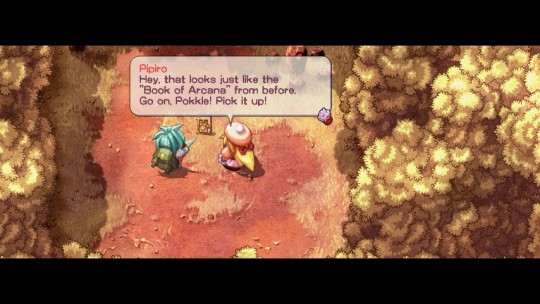
I love it when RPGs include that kind of attention to detail, and that’s really just one example of many. But there’s still more to discuss, too. Like the new stuff we added to fill in the gaps left behind by stuff we couldn’t quite include from the 2001 Japanese release.
See, in the original Japanese version of the game, there were three launcher apps you could unlock in addition to all the minigames: an alarm clock, a calculator, and a calendar. Matt (this game’s intrepid programmer, if you’ll recall) was originally going to port all three of these over into the final English version of the game, making them available to display on the HUD alongside the Pet Monitor, but he ran into some unexpected technical and logistical difficulties doing so. By the time he encountered these difficulties, he’d already successfully ported over the clock, but he was struggling with the calendar in particular.
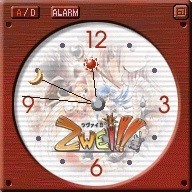
Behold the glory of the Zwei clock! Also available in digital form – just click that little “A/D” button.
This was when we realized, there’s not really any use whatsoever for a calendar or calculator in-game. Like, at all. I mean, I guess the same could be said of an alarm clock, but at least theoretically, if you’re playing the game in full-screen and you’ve got a hot date later or something, you could set yourself a reminder alarm for when you want to save and quit so you can get ready. (I dunno! It’s plausible, right? Right?!)
So the calendar and calculator were disabled. RIP, outdated desktop apps!
…Except, hold on. It turns out there’s actually an optional boss in the game that you can only get to by unlocking the clock, calendar, and calculator. Yes, seriously.
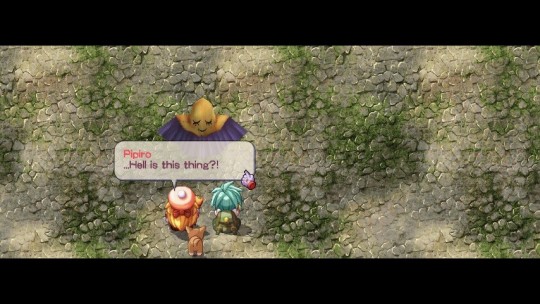
This means we had to replace the two missing apps with something else that could trip the same event flags. So I thought about it for a bit, and two new items were born: the “Clock Manual,” and the “Clock Warranty.” These two book items replace the calendar and calculator, and when used, they expand upon the lore of the clock (now the “Cursed Clock”), directly relating it back to the optional boss in question and giving tips on how and where to find him.
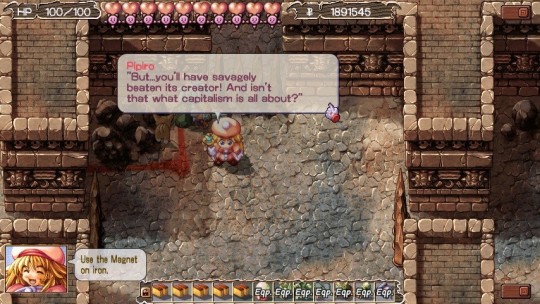
That’s not the only time we found that something in the game was more than meets the eye, though. Remember how in my previous blog, I said there was about two and a half games’ worth of text in the game’s files, including character backstories and plot arcs that were apparently cut from the final release? Well, some of that belonged to a hidden robot. And that particular text wasn’t quite as unused as I first thought.
We didn’t know this robot still existed in-game until we were deep into QA, but you have to find him in order to get one of the items necessary for 100% achievement completion on Steam or GOG Galaxy, so it was inevitable we’d come across him sooner or later. And while his original text unfortunately could not be included in the English version of the game as-is, the robot is still there, with a little bit of newly written text for your perusing enjoyment. And he still gives you one of the items you need in order to get all the achievements, so be sure to keep an eye out for him as you play! If you want to know where to find him… well, here’s a hint: this is the controller I switched to in order to accomplish the particular feat required to test his new dialogue.

You could say it met my… needs.
You may not have to do the same. You may be a far more accomplished gamer than I. But for me, this was the best option I had, and it worked like a charm. (Plus, it was IMMENSELY SATISFYING to play Zwei: AA and achieve something noteworthy using an MSX controller… but that may just be the MSX enthusiast/gaming hipster in me talking!)
Anyway, speaking of finding very well-hidden things, this game also has 16 collectible “bromides” in it. Remember the bromides from Lunar? Yeah, they’re kind of like that, only… less naughty.
In fact, in the original Japanese, they were MUCH less naughty. Because they didn’t do anything. They were literally just collectible items that took up space in your inventory. Catch ‘em all, and you got… the satisfaction of knowing you caught ‘em all! Which is fine, of course, and certainly not without precedent – I’ve played many other games that have had similar collection elements in them – but we thought it was a little bit of a shame to have these items in the game without giving the player a chance to actually look at them. So… we contracted the same artist who drew all our achievement icons for both Zwei titles to draw full-sized images for all 16 bromides as well.
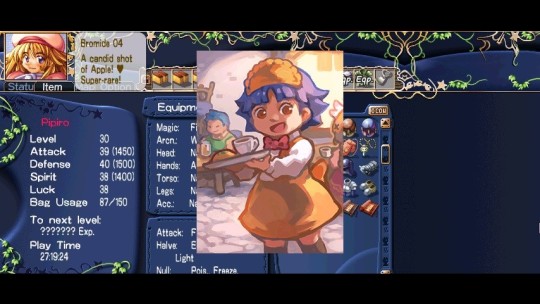
Yep. The bromide pictured here is one of the easier-to-find ones (though none are actually easy to find), but there are 15 more out there, just waiting to be seen! (And like this one, most of the others have secret cameos in them by characters from other Falcom titles, added with the full support and permission of Falcom themselves.)
We also hired an artist whom we’ve worked with in the past (on Ys: The Oath in FelghanaandYs Origin) to help expand some of the 4:3-resolution game areas and system screens to display in 16:9 without breaks in the art. Over time, his involvement grew, and he wound up designing a handful of tutorial images for us (since this game never previously had any in-game instructions or tutorials whatsoever, and is decidedly not intuitive enough to get away with that!). And boy oh boy, are these tutorials ever something special…

He also did a bunch of other stuff, including creating images for each of the status ailments, implementing virtually all our translated Japanese graphic text, and redoing the look of the arcade machines in “Undine Land” (you’ll find out about this place when you play) to better reflect the games contained within them.

Pretty nice, huh? Certainly makes The Typing of Ys feel a little more like it belongs in-universe!
So, yeah. This isn’t just a simple localization, nor is it really a port. It’s not quite an uprez, and it’s not quite a remake. It’s something altogether unique, and decidedly very special to us – to all of us who’ve involved ourselves with this game. It’s something we’ve poured our hearts and souls into, doing everything in our power to make it the best version of Zwei!! the world has ever seen, and to ensure you have a truly memorable and rewarding gaming experience when you play it. And we all hope very much that you do indeed love playing it as much as we loved working on it.
Be sure you don’t miss this one when it releases on January 24th.
(Oh, and check out the website, while you’re here. It’s pretty outstanding! Particularly that Characters section. Don’t think we’ve ever had something like that before on one of our sites, and it truly is something to behold!)
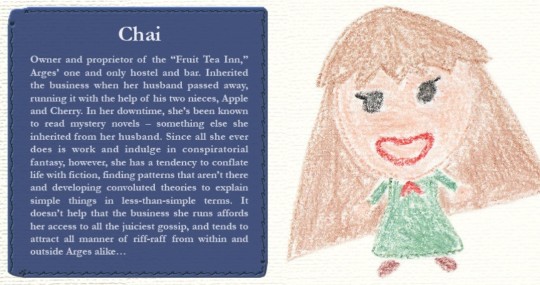
You can see the full roster at http://www.visitarges.com, along with a bevy of other information about the game!
Anyway, take care, future Zweiholics! May we meet again somewhere, someday, in the vast expanses of Granvallen!
Tom here again, for more fanboy gushing over Zwei: The Arges Adventure!
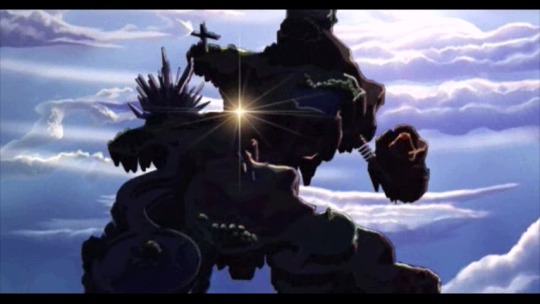
I’ve already touched on the game’s amazing script, and I’ll definitely go more into that in my next blog entry (there’s a lot to talk about there, as this is easily the strangest script I’ve ever worked with, on multiple levels!), but I figured I’d take this opportunity now to instead discuss some of the new and updated features that our amazing programmer was able to cram into this release. I’d rank most of these under the “quality-of-life improvements” category, though some are more along the lines of old but notable features from the original 2001 PC version which have been adapted to run more readily on modern systems and integrated more thoroughly into the game proper.
Note that in all cases (except where otherwise noted), the original functionality from the 2001 Japanese release still applies – there are just additional options now as well. Also note that while the additional options described all reference making use of controller buttons, allowances have been made for keyboard shortcuts that fulfill the same functions when applicable, so you keyboard-and-mouse gamers should reap some benefits of Matt’s coding prowess as well.
Anyway, let’s dive right in, shall we?
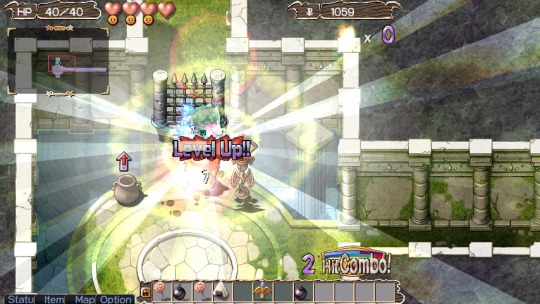
Feature: Quick-using food items in the heat of battle.
How it works in the 2001 Japanese release: In order to use an item, you first have to make sure it’s located on your hotbar (which has 12 available slots). Then, during gameplay, you have to either right-click the item with your mouse, or press the item’s corresponding function key (F1-F12) to use it. If you don’t want to drop your controller to use the mouse or keyboard for this task, no problem: there’s a button you can press that moves control of the game down to the hotbar, at which point you can press left and right to cycle through to the item you want, then press another button to use it. Afterward, you can press another combination of buttons to deselect the hotbar and return to regular gameplay. Time does NOT stop while you do this, however, so good luck surviving the enemy onslaught as you attempt to perform all these tasks!
How it works now: Just press one controller button to instantly use the left-most consumable healing item on your hotbar. After doing so, all other consumable healing items contained therein will shift left as far as they can go, ensuring that the slot you just freed up by using that one item is now located along the right side of the hotbar rather than the left. The reason for this? Well, when you pick up new items, they get sent to your hotbar first, as long as there’s space for them there. And if the blank slot on your hotbar happens to be all the way on the left, then whatever item you just picked up will end up being the first one you use next time you press the item button. But if the blank slot is on the right, whatever item you just picked up will be the LAST one in line for use – meaning, you can customize your own personal “eat list” that determines exactly what items you use on the fly, in exactly what order. Bit of an improvement, wouldn’t you say?

Feature: Switching magic/tools in the heat of battle.
How it works in the 2001 Japanese release: Your hotbar doubles as your equipment slots, so the only way to equip a magic jewel (which determines Pokkle and Pipiro’s attack type) or specialty tool (which allows for various puzzle-solving special abilities) is to add it to your hotbar, then “use” it (via one of the methods listed in my previous feature description), which places the Japanese equivalent of an “Eqp.” symbol over it, signifying that it is now equipped and ready to use. If you “use” that same hotbar slot again, you’ll unequip that item. And if you want to switch to a different magic jewel or tool… well, you either need to open your inventory, drag the new item onto the hotbar in place of the old one, then right-click it to equip it and close your inventory, or – alternately – just keep every equippable magic or tool you think you might be using in the near future on your hotbar (never mind all the food items this is preventing you from prepping!), and press the corresponding function key on your keyboard to equip it whenever the need arises. Siiiimple, right?
How it works now: Whatever your controller’s equivalent of the L1 and R1 buttons happen to be can now be used to cycle through all of your available magic and tools via a single hotbar slot. If you have no such item in your hotbar, but you’ve got one in your inventory, no problem: pressing L1 or R1 will automatically equip whatever you’ve got available into the first available hotbar slot. And from then on, you can just press L1 or R1 to instantly swap it out for whatever the previous or next equippable item in your inventory happens to be. Even unequipping your magic is part of the cycle, for those rare times when you’re attacking enemies who have resistance to all elementals, or when you’re attempting to solve puzzles that call for the use of Pipiro’s base magic.
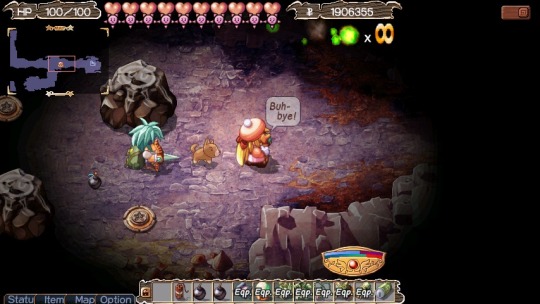
Feature: Dropping bombs or dynamite to blow up enemy artillery or large rocks.
How it works in the 2001 Japanese release: Oh, this one is really fun. Or rather, “fun.” In quotes. See, bombs and dynamite don’t work the same way as any other items. You can’t “use” either of them – attempting to do so will simply do nothing at all. Instead, you have to “discard” them. Using a mouse, this is accomplished via drag-and-drop; assuming there’s a bomb or piece of dynamite on your hotbar, you’ll need to click it and hold the mouse button, then drag it onto the main game screen somewhere and let go to drop it at that spot and set its 3-second fuse. This is made considerably tougher if you’re using a keyboard or controller, since you’ll have to press the button that transfers game control over to the hotbar, scroll over to the bomb or dynamite, press and hold the item-move button, then use the D-pad or arrow keys to move that item onto the main game screen, and finally let go of the button to drop the bomb/dynamite and set its 3-second fuse. But even after that, you’ll need to use the previously mentioned button combo to transfer control back over to your characters before you’re able to move out of the way of the explosion, which… doesn’t always happen in time. And worst of all, if you use any of these methods to attempt to drop a bomb or piece of dynamite, but the location you’re trying to drop it is considered invalid (maybe it’s a little too close to a wall, for example)… well, it’ll just cancel the whole operation and force you to do it all over again. There’s no mincing words here: using bombs and dynamite in the original version of this game suuuuuuuucks…
How it works now: Erm… you press the SELECT button. Basically, if you have at least one bomb or piece of dynamite on your hotbar, pressing the SELECT button will automatically drop it (or drop the left-most bomb or piece of dynamite, if you have multiples on your hotbar) at the closest valid location. That’s literally all there is to it!

Feature: Switching characters on the fly.
How it works in the 2001 Japanese release: There are three options. (1) You can click the character portrait on the bottom-left of the screen. (2) You can press the button to transfer control of the game to your hotbar, then move the cursor over to the portrait on the bottom-left of the screen and “click” it with the item-use button. (3) You can press the Esc key twice, though only if you’re standing still and… really, only if the game feels like honoring those keystrokes (it gets temperamental sometimes). Those are your options.
How it works now: …Yeah, uh, there’s a button for this now. In fact, since Zwei: The Ilvard Insurrection allows for two different control schemes (one button to attack, one button to switch characters; or, one button to switch to Ragna and perform a melee attack, one button to switch to Alwen and perform a magic attack), we decided to mirror that functionality in Zwei: The Arges Adventure with protagonists Pokkle and Pipiro. So whichever option you liked better in the other Zwei game, that option will be available to you here as well!
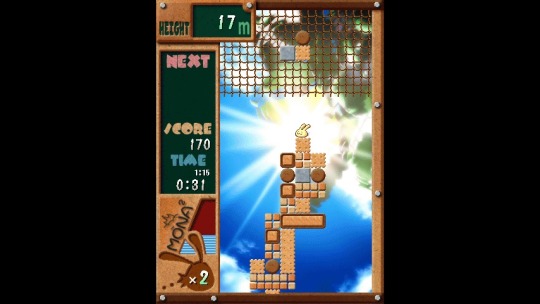
Feature:Playing the “Typing of Ys” and “Mona, Mona” minigames.
How it works in the 2001 Japanese release: These two minigames consist of an Ys-themed typing tutor and a reverse block puzzler (your goal is to avoid making combos at all costs, since you’re trying to build a sturdy block ladder so an infatuated bunny can climb to the top of the level and rendezvous with his true love). They’re pretty awesome. But they’re also a little… unusual in how they’re played. Basically, you have to unlock them in-game through special means, after which point you’re told that “something seems to have happened on the desktop.” Now you can play them whenever you want… from the launcher. You know, the window that pops up when you first boot the game, which allows you to adjust config settings and such? Yeah. You have to exit Zwei in order to play either of these minigames, because they’re only executable from that. They’re part of a small collection of what I’ve come to call “desktop apps,” which also include the likes of a clock, a calendar, and a calculator – all of which are usable ONLY from the launcher.
How it works now: First off, I should note that there is no launcher anymore in our English version of the game. At all. Matt doesn’t believe in launchers, and intends for every configuration option to be accessible and adjustable solely from within the game. So running these minigames from the launcher is simply no longer possible. But that’s okay! It’s kind of beside the point, in fact. The thing you really need to know here is that there’s a third notable minigame as well, called “Zwei Shooting.” It’s a classically styled shoot-em-up (also known as a “shmup,” if you’re rad), and it’s playable (in all Japanese versions of Zwei!! and in Zwei: The Arges Adventure alike) via an arcade cabinet in one specific town. This town has three other arcade cabinets right next to Zwei Shooting’s, but none of them actually have any games attached to them: one just shows you the instructions for Zwei Shooting, and the other two are literally just there for decoration. So we decided, why not assign the “Typing of Ys” and “Mona, Mona” minigames to two of the unused arcade cabinets? And while we were at it, we decided to make them playable right from the start, so as soon as you get to this town, you can play either (or both) of these minigames to your heart’s content! (Which means the conditions for unlocking them in the Japanese version now net you something else entirely, of course…)

Feature: Guiding your pet through dungeons and collecting items via the “Pet Monitor” app.
How it works in the 2001 Japanese release: Once again, this is a “desktop app” that you can run only via the game’s launcher, though this one is available anytime after you’ve acquired a pet in-game. This particular app, however, is largely passive, as your pet meanders through town and into dungeon areas, only occasionally reaching a crossroads or being forced to make some other binary decision (Go left, or go right? Fight the wildcat, or run away? Enter this new dungeon area, or go back home?). When the time comes to make one of these decisions, the pet will turn to face the camera, and you’ll be given the two possible options to select from. Mouse over the one you want (or wait a few seconds and let your pet make up its own mind), and then just keep on watching as the adventure unfolds. Your pet’s exploits can ultimately net it level-ups that will help it be a more effective AI companion during battle in the main game, or perhaps it can net you some extra food items to be used in your own adventures (which are transferred to the storage chest in Pokkle and Pipiro’s house next time you load a save-game).
How it works now: Once again, since there’s no launcher anymore, there’s no more Pet Monitor desktop app. What there is, however (and I’m going somewhere with this, I swear!), is the ability to leave your pet behind at Pokkle and Pipiro’s house as you go off on your journey. This option exists in the original Japanese version too, but there doesn’t seem to be any reason to ever make use of it – there’s never a time when leaving your pet at home would be more beneficial than bringing it with you. But now, it all makes sense! If you leave your pet behind, the Pet Monitor app will automatically appear as part of the HUD when you leave Puck Village, and it will remain on display (with the option to minimize it) the entire time you continue your adventure. So while you’re off fighting monsters and winning back your stolen macguffins, your pet is out somewhere in the same set of dungeons at the same time, finding treasure and fighting wildcats! And any time one of the Pet Monitor’s binary decisions appears on the screen, you may either mouse over the desired option to select it as before, or – if you’re in the heat of battle and can’t put your controller down, for instance – press the L2 or R2 button to select one of the two options without ever having to disrupt your flow. Finally, when you return to Puck Village, the Pet Monitor will automatically minimize as your pet hurries home to pretend like nothing ever happened. It’s the very model of efficiency, and adds a whole new level of meta-gaming to your journey!
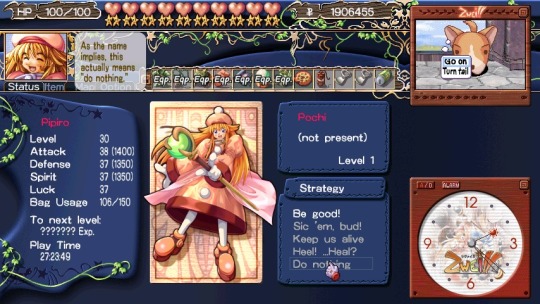
There’s plenty more to discuss, as there have been a bevy of other adjustments made as well (not just mainstays of PC production like widescreen support and achievements, but also simple yet welcome tweaks like the addition of a single button to open the inventory screen, or the streamlining of the game’s formerly rather cumbersome shop functionality). But this blog entry is already quite long, and some of the additions we’ve got on tap are directly tied to the game’s text in some manner… so those are stories best saved for next time around!
Until then, take care, and remember: if you tweeted about this blog entry on behalf of XSEED Games, chances are you Arges.*
…What can I say? When it comes to puns, I’m all about the low-hanging fruit, because it’s just so Ysy. So try not to Mona Mona too loud about it, and just keep on Monitoring this Tumblr for future updates!

Pipi, cheeri-ro!
*Note: This is actually not the case, as the person who Isges is currently off becoming a Mother 2.0. But the pun was deemed worthy of standing on its own merits, and has thus been left intact for your groaning enjoyment!
AAAAAAHHHHH IT’S FINALLY HAPPENING.
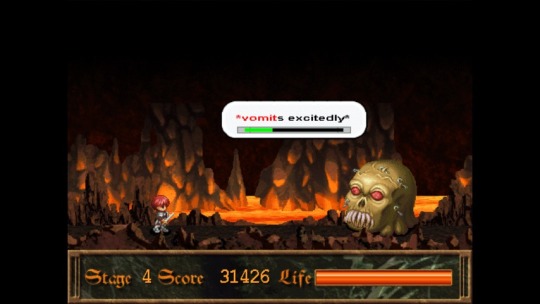
I’ve been working on this game for the better part of a year now, but have been unable to say anything about it for PR reasons – namely, that it wasn’t in a showable state, and we didn’t want to confuse prospective players by having two Zwei games announced but unreleased at the same time. Which is totally reasonable, but AAAAAAAHHHH I’VE BEEN WANTING TO TALK ABOUT THIS GAME SO BADLY YOU HAVE NO IDEA.
…Ahem. First off, I guess I should bring you all up to speed, in case you missed the announcement. Falcom’s 2001 PC classic Zwei!! is coming to the Western world via Steam, GOG, and The Humble Store in early 2018, under the name Zwei: The Arges Adventure. Why the name change? Well, because we already released its 2008 sequel, Zwei: The Ilvard Insurrection (which was originally called Zwei II: Sky-High Great Adventure in Japan).

That’s right. Localization work wrapped on the sequel first, and now we’re finishing things up with the original.
What are we thinking?!, you must be asking yourselves. Why would we release the sequel first, then go back and release the original? Why wouldn’t we release the original game first? And since we’ve already released the more modern second entry in the series from seven years later, can this earlier effort really hold its own by comparison?

Well, that’s why I’m so excited. Because Zwei: The Arges Adventure is good. REALLY good. In fact, I dare say it’s my favorite translation I’ve ever worked on to date – yes, even topping Return to PopoloCroisandCorpse Party. And if you’re at all familiar with me (this is Tom, BTW), that statement alone should tell you that Zwei: AA is something special, since PopoloCroisandCorpse Party are… shall we say, perennial favorites of mine. To put it very lightly.
So, yeah. Let’s address those hypothetical questions, shall we?

Why would we release the sequel before the original? Well, two reasons. One, because we can – these games each tell standalone stories, set on different floating continents with different casts of characters. Zwei: AA’s two protagonists, Pipiro and Pokkle, do make a few cameo appearances in Zwei: II, but this is done almost purely for the sake of fanservice (the literal kind, not the naughty kind). When all is said and done, these two games are completely standalone, taking place in the same world but telling very different stories with very different characters and a very different feel. Think of it kind of like the Ys series, but even more episodic (since, Ys Originaside,Ys has the Adol-as-protagonist connection from one game to the next, whereas Zwei doesn’t even have that!).
The other reason is because of the nature of Zwei: AA’s code. The Japanese version of this game utilized DirectX 5, was formatted strictly for 4:3 resolution with no widescreen options whatsoever, offered a lovely FPS selection of 30 or 15 (seriously!), counted on players to play it with mouse and keyboard over gamepad (it supported gamepads, but… barely), and contained no fewer than six unlockable Windows desktop apps that were loosely tied to yet completely separate from the main game.
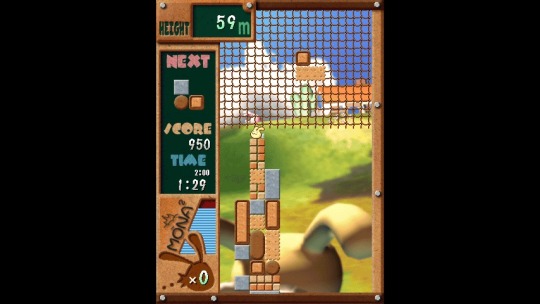
This is one of them. And that first screenshot at the beginning of this blog entry is another.
In other words… this is the kind of adaptive coding project that’s been known to give lesser programmers heart attacks. Getting a game like this to even run on a modern Windows machine at all – much less run WELL – was decidedly not a task for the meek. In fact, it’s because of the way this game is coded that we ultimately decided to translate the game in-house rather than working with any fan-translators as we did for Zwei: II, as no two programmers would handle this text the same way – and trying to convert a fan-translated script to a format that would work for us would’ve taken almost as long as translating the game from scratch.
So, yeah. Getting Zwei: II out first was pretty much just done because… erm… it was ready first. And it was always GOING to be ready first. Even with a lengthy QA process and a couple minor delays, it still inevitably got finished long before its predecessor was ready to make its debut.
Fortunately, we hired a veteran programmer to work with us on Zwei: AA… but you’ll never guess who! It wasn’t Sara, since she was busy getting Zwei: II ready at the time (and a fine job she did of it, with one of our smoothest PC launches ever!). But this wasn’t our first time working with the guy we worked with on this project, either. It was, however, our first time working with him to modernize someone else’s game – and he really did perform some miracles for us (and put up with my many, many demands for quality-of-life improvements and feature additions, to boot!).
The man in question? Matt Fielding, of Magnetic Realms. A.k.a. the guy who brought you the game Exile’s End.
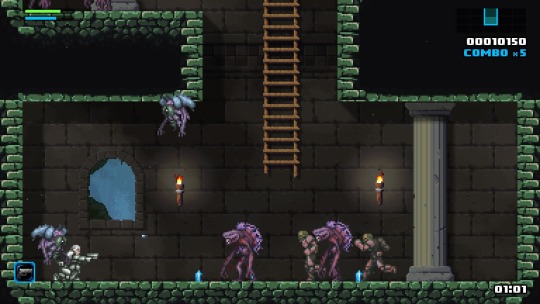
Pictured: Exile’s End. Which is also an awesome game you should play!
And thanks to his technical wizardry, you guys are going to have an astoundingly up-to-date version of Zwei!! on your hands at launch. We’re talking more than just widescreen support here – there’s full in-game integration of the Pet Monitor and other desktop apps, new control functionality for more natural gamepad support across the board, inclusion of the arranged soundtrack from the Japan-only PSP version of the game, additional art and text content not present in any previous version of the game, and much, much more (to be detailed in future blog entries!).

Moving on to the second question I asked, with Zwei: II already out, can Zwei: AA hold its own by comparison?
I think you know what my answer’s going to be, on that one. Zwei: The Arges Adventure is a freaking awesome game with a lot to offer, and differs from its own successor in enough key areas that it can very easily hold its own any day of the week. Hell, you might even like it better than Zwei: II – it’s certainly a very close call for me, but I’d say Zwei: AA gets the slight edge!
Sure, they’re both dungeon-crawling action RPGs at their core, and they both use food to level-up, even sharing the same food exchange system to discourage grinding. And the two-character party (plus one pet), with one character taking the role of physical attacker while the other slings spells, takes center stage in both titles as well. Plus, both games are set on floating continents in the same world.

That’s a lot of similarities, but they’re all relatively superficial. You could say Zwei: AA is like the 2D answer to Zwei: II’s 3D world, but that would be discounting its snarkier and more tongue-in-cheek storyline (yes, even more than Zwei: II’s!), or the gorgeous and ludicrously colorful hand-drawn backgrounds, or the two games’ very different approaches to pets (you only get one pet in Zwei: AA as opposed to the veritable army of pets featured in Zwei: II, but that one dog or cat [or other?] has significantly more personality and gameplay involvement than its many Zwei: II counterparts), or the huge variety of minigames on offer (all of which have been adapted to play from within the game itself, despite formerly existing only as desktop apps)… and that’s just scratching the surface. In short, although the two games use the same basic template, they represent two very different approaches to game design within the confines of that template.
For me as Zwei: AA’s translator, though, I can’t help but laser-focus right on the game’s dialogue. Protagonist duo Pipiro and Pokkle are without a doubt the best pair to write that somebody like me could ever ask for. Pokkle constantly cracks bad puns (and I do mean constantly!), wears a tail for funsies, and is always hitting on women twice his age.
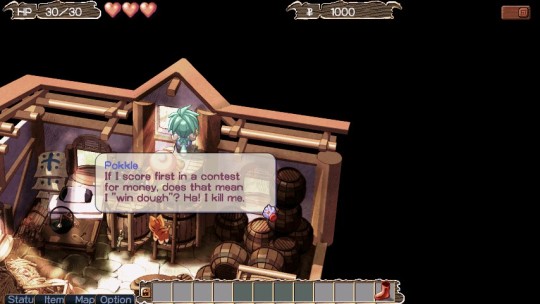
And Pipiro just has absolutely no filter whatsoever, and is full of so much snark that she’s fit to burst.
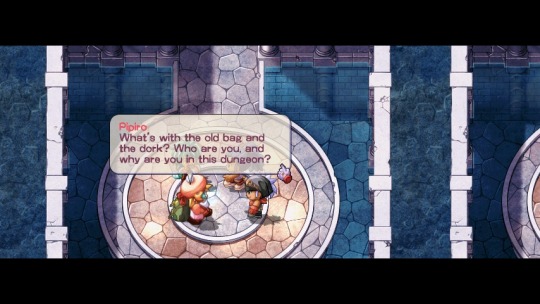
Practically every line out of these two is an absolute gem – and that’s to say nothing of the many quirky NPCs surrounding them over the course of their rather lengthy quest (such as the endlessly self-delusional “libertine fatass” that’s funding your adventure, and his extremely no-nonsense maid who gave him that nickname).

I… really can’t stress enough how much fun it was to write for these characters, and how inspired I was to come up with the perfect phrasing for every line. I’m extremely appreciative that we chose to translate the game in-house, as it gave me an opportunity to work much more deeply with this script than I ever could’ve if we’d only been tasked with editing it. As time went on, I found myself revising my work on a daily basis, making small tweaks here and there as new bits of wordplay or better puns popped into my head (much to Matt’s chagrin, I’m sure!). The end result is something that I can stand behind as a faithful interpretation of the game’s mood and intent – an attempt to convey the same degree of lighthearted fun and irreverence present in every line of the Japanese script, but formatted to sound more natural in English, accounting for context, tone, atmosphere, and individual character quirks rather than just hammering out a word-for-word translation.
I’ve never laughed so hard while playing a JRPG before, and I truly hope that when you guys play this one in English, you’ll find its English interpretation just as hilarious as I found its original Japanese to be. That would mean I succeeded at what I set out to do, and would bring me great joy and pride as a localizer!

And please do keep an eye on this Tumblr, as I fully intend to give lots more info about Zwei: The Arges Adventure (and more screenshots showing off lines I’m particularly proud of) in the weeks to come!
Until then, I hope you’re all continuing to enjoy Zwei: The Ilvard Insurrection, and… well, I’mma go back to testin’ Zwei: The Arges Adventure now, ‘cause I want this game to be downright perfect when it’s released! And with translation and editing 100% complete, and coding probably somewhere in the 70-80% done range, that release date will be here before you know it…
“Bring us Ys SEVEN on PC!”, the players said. “We want Ys SEVEN on PC!” The rallying cry echoed forth from all corners of the internet, and we knew it was only a matter of time before it echoed so loudly as to become almost deafening. Thus, we decided to silence the cries by giving the players what they wanted… and so Ys SEVEN PC came to pass, with its launch scheduled for August 30th (so soon!) on Steam, GOG, and the Humble Store by Humble Bundle.

But aside from a handful of screenshots and some emphatic assurances of quality, we’ve said and shown very little of this port, leaving you all to wonder, will it be any good?
Well, wonder no longer! I’m here to address all your concerns and assuage all your fears! So… let’s get right into it, shall we? We shall proceed in the tried-and-true form of the classic Q&A!
Q: Is this version of the game based on the Chinese PC port of Ys SEVEN from Joyoland?
A: No, it is not! This is a completely new port contracted by us. See my answer to the next question for more details.

Q: Is Durante porting this game?
A: No, he’s not. Nor is this a port from our regular programming guru, Sara. Due to the recent increase in the volume of PC titles we’ve been releasing, we’ve been forced to branch out and find new sources of programming wizardry to work with – and just as we’re very careful when selecting localization contractors to work with, we try to be very selective about whom we entrust with our partners’ code.
Since the particular group we’re working with for Ys SEVEN hasn’t yet come out and spoken of their involvement, we’ll respect their privacy and not name any names (you’ll be able to find out who it was soon enough when the game releases), but we will say this: these guys are GOOD. It’s a Japanese company that’s done extensive work on PC and console games alike, and they take a lot of pride in what they do.
Having never worked with this company before, we were initially wary (as we always are when working with somebody new for the first time), but they almost immediately proved themselves a true force to be reckoned with. The very first build of the game they sent us was basically a 100% playable port of the Japanese game from PSP to PC, complete with upscaled HD visuals and a 60 fps framerate. It looked great, played great, and ran perfectly on every one of our PCs. Plus, it was delivered to us much, much sooner than we expected.
And this was just a quick and dirty proof-of-concept build!
So if you’re worried about how the game will run on your system, or whether the port will even be any good… don’t be. These guys (who are apparently pretty big fans of the Ys series to begin with) clearly know their stuff, and have been an absolute joy to work with. We hope to employ their services again on future PC projects, and we hope you guys enjoy the fruits of their labor come August 30th.
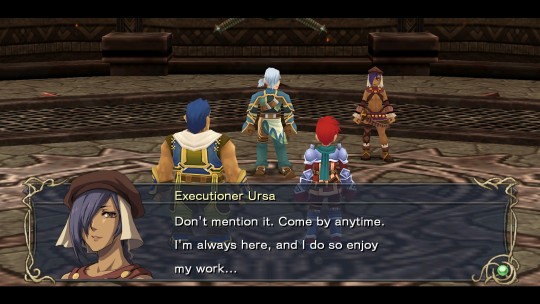
Q: Will the PC version of Ys SEVEN have all the same features Durante added to the PC version of The Legend of Heroes: Trails of Cold Steel?
A: Sadly, no, because most of those simply wouldn’t apply to Ys SEVEN. Remember, this is a game that was developed for the PSP, whereas Trails of Cold Steel was developed for the PS3. As such, there are limits to the visual enhancements that can be applied – without completely remaking the game from scratch, there will always be restrictions present here that you wouldn’t find in a game designed for HD visuals from the start. The most noticeable of these are the game’s textures, many of which don’t exist in high-res form. We experimented with upscaling these textures, but the results looked… less than ideal, and wound up highlighting other flaws (such as introducing very obvious texture seams and mismatches which are otherwise virtually unnoticeable).
Now, don’t go thinking this means the game will just look like a PSP title blown up to fill an HD screen! Far from it. Even if the textures are still rather lo-res in spots, the 3D models are all sharp as can be, with characters faring particularly well. There’s a lot more detail present on the characters now than ever before, helping to highlight their impressively fluid animations – and those animations look *especially* fluid at 60 fps!
But we do worry that those of you who’ve played Trails of Cold Steel PC might be a bit spoiled for choice after bearing witness to the sheer breadth of options available in that game’s admittedly brilliant launcher, so consider this a bit of advance notice: the launcher options for Ys SEVEN are far more basic, but the end result is a game that’s just as lovingly ported, and just as big an improvement over the original version. We feel that if you go into it with this caveat in mind, you’ll find yourself equally impressed with the end result.
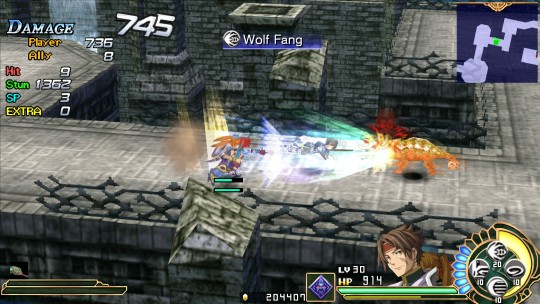
Q: What’s this I hear about the text being updated?
A: Yep! As long as we were working on this game anyway, we figured, why not make some improvements in the process?
See, Ys SEVEN was the very first editing project I ever worked on when I was hired as a Localization Specialist for XSEED Games over seven years ago… and I was hired near the end of the project’s production cycle, so I had precious little time to work on it. I had a lot of help from our esteemed former editor Jess (whom many of you may know as the sharer of blobfishes on our Twitter, among many other things), but the time constraints and my overall newness meant that my editing wasn’t all it could’ve been, and a lot of minor errors slipped through the cracks. In addition to typos and grammar errors here and there, there were even spots where I’d gotten the context of scenes wrong, as well as a general inconsistency in terminology and capitalization rules from one file to the next. It’s mostly stuff that wouldn’t be noticed by the average player, but I’m certain some of you language nerds like me who played Ys SEVEN on PSP must have cringed at least once or twice before its conclusion (and not just from my poor attempts at humorous interjections).
But all that changes now! …Or most of it, anyway. I’m sure we didn’t catch everything, and there are still plenty of issues with the text only filling up a small portion of the dialogue window in which it appears (this was tied to the text limits we were initially given when working on this game seven years ago, so it was a bit too universal to address across the board). But the fact is, we made changes to over a thousand lines of text – most just minor corrections to spelling, punctuation, or word order, but some consisting of complete rewrites for better clarity or more accuracy to the original Japanese – so we’re pretty confident in saying that any returning Ys fans who play this game should find themselves more immersed now from beginning to end than they were seven years ago, and new fans playing it for the first time will have the best possible experience doing so.
And I’ve gotta say, it feels good to have revisited this text and made some of the corrections I’ve been dying to make for the better part of a decade! It definitely adds a sense of closure to my beginnings at XSEED, and I hope you all are able to notice some of these differences and appreciate the hard work that the whole localization team put into them – because this wasn’t just me going back and fixing things, but all of us making a group effort to give this script a new lease on life. It’s like we all banded together for a common cause, and I couldn’t be prouder to have been a part of it. And even though the majority of our changes are so small that you may not even notice them, we believe that the subtle effect they’ll have on your ability to become engrossed in the game’s world will make all of our efforts totally worth it in the end!
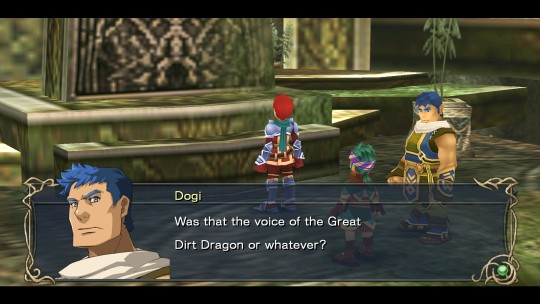
Q: Can we expect more ports like this in the future?
A: You’ll just have to wait and see! If we haven’t announced it, we can’t say anything about it. But that doesn’t mean we don’t have things in the works behind the scenes!
* * *
So, did I miss anything? If you have any further questions, feel free to pose them on our Facebook or Twitter – or on our forums at www.xseedgames.com if you want to reach out to me directly, since the forums are my usual stomping grounds.
And come August 30th (my birthday!), I hope you all have an awesome time with Ys SEVEN. As of today, it’s been exactly seven years since our initial release of the game, and while we weren’t quite able to time the release of the PC version so it fell on the same day, we’re thrilled we can bring this wonderful game (one of my personal favorites in the whole series) to a wider audience, and we hope to hear nothing but good things from you guys as you sink your teeth into it in two weeks.
Please enjoy your time in the land of Altago, everyone!
-Tom
